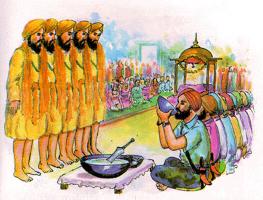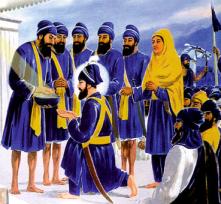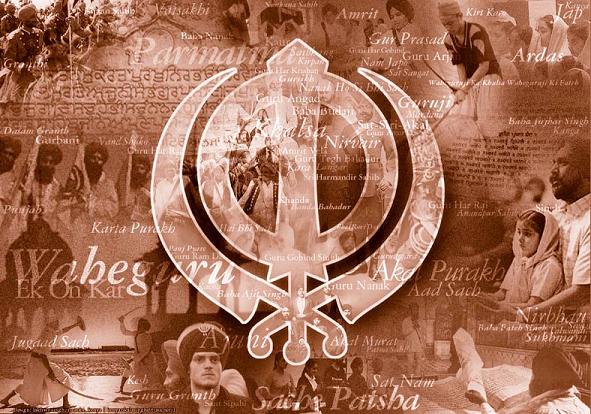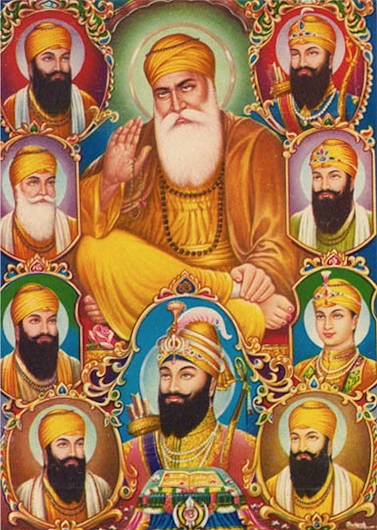Historically speaking, Amrit is Nectar or holy water used to initiate the Sikhs into the order of Khalsa Brotherhood. It is cognate to ambrosia which means water of immortality. It is the elixir of life which bestows immortality. It brings the dead to life and makes human beings immortal.
Literally, Amrit is combination of two words i.e. Am-Mrit.
Marit means death-mortality and Am-Mrit means immortal, which never dies. It is called Abe-Hyat in Persian and Nectar in English.
Amrit is prepared by dissolving sugar crystals (Patashas-sugar plums) in water and stirred by Panj Pyaras with two edged Khanda to the accompaniment of scriptural recitation of five sacred Banis. Amrit is supposed to confer eternal life on the neophytes. Any person who undertakes Amrit, is blessed with Naam Daan, humility, sweet nature and dedication to the service of mankind irrespective of caste, color and creed. Amrit turns pacificists into saint-soldiers and prepares them to die for a righteous cause and seek unity with Almighty Lord.
Macauliffe writes,
“The Guru caused his five faithful Sikhs to stand up. He put pure water into an iron vessel and stirred it with a Khanda or two edged sword. He then repeated over it the sacred verses which he appointed for the ceremony, namely, the Japji, the Japji, Guru Amar Das's Anand, and certain swaiyas or quatrains of his own composition.”
The Sikh Religion by M.A. Macauliffe, V-5, p.94
Through Amrit, the novice is born again, but this time on a spiritual level instead of physical level.
Amrit is not a simple water. It is the Naam of Akal Purakh. It is Sat, Santokh and Vicharo as enshrined in Sri Guru Granth Sahib. It is spiritual food for the soul.
“Amrit Naam Thakar Ka Paiyo Jis Ka Sabhas Aadharo”
Amrit is acquired through guidance and grace of the Guru
Guru Amar Das says,
“The angelic persons and the silent sages search for the Divine Nectar. That Nectar I have obtained from the Guru.”
ਸੁਰਿ ਨਰ ਮੁਨਿ ਜਨ ਅੰਮ੍ਰਿਤੁ ਖੋਜਦੇ ਸੁ ਅੰਮ੍ਰਿਤੁ ਗੁਰ ਤੇ ਪਾਇਆ ॥
(918)

On the day of Baisakhi in 1699, Guru Gobind Singh performed the ceremony of preparing and administering Amrit (Khande-di-Pahul) for the first time to the five Sikhs and brought them into the Khalsa Brotherhood at Kesgarh Sahib in Anandpur.
As already quoted, literally, Amrit means deathless, immortal, imperishable, ambrosia or nectar like food. It has the significance of attaining immortality and eternal bliss.
Guru Arjan Dev says,
Amrit (Nectar) is your Name O God, whosoever drinks it, is satiated.
ਅੰਮ੍ਰਿਤ ਨਾਮੁ ਸੁਆਮੀ ਤੇਰਾ ਜੋ ਪੀਵੈ ਤਿਸ ਹੀ ਤ੍ਰਿਪਤਾਸ ॥
(1208)

Ambrosia is the True Name but one can say not its praise.
No sooner does the man drink the Name Nectar then he becomes acceptable and gets absorbed in perfect Lord.
ਅੰਮ੍ਰਿਤੁ ਸਾਚਾ ਨਾਮੁ ਹੈ ਕਹਣਾ ਕਛੂ ਨ ਜਾਇ ॥
ਪੀਵਤ ਹੂ ਪਰਵਾਣੁ ਭਇਆ ਪੂਰੈ ਸਬਦਿ ਸਮਾਇ ॥
(33)
Nectar is Lord’s Name which I ever meditate.
ਅੰਮ੍ਰਿਤ ਹਰਿ ਕਾ ਨਾਉ ਸਦਾ ਧਿਆਇਆ ॥
(517)
Guru Amar Das says,
Thus thou shalt abide in thy own home, drink Nectar and get at the peace of Lord’s presence.
ਨਿਜ ਘਰਿ ਵਸਹਿ ਅੰਮ੍ਰਿਤੁ ਪੀਵਹਿ ਤਾ ਸੁਖ ਲਹਹਿ ਮਹਲੁ ॥
(37)
Quaff thou, the immortalising Nectar of the Guru’s Word.
ਗੁਰ ਕਾ ਸਬਦੁ ਅੰਮ੍ਰਿਤ ਰਸੁ ਚਾਖੁ ॥
(178)
Thus shalt thou taste Nectar relish the Supremely precious commodity.
ਮਹਾ ਪਦਾਰਥੁ ਅੰਮ੍ਰਿਤ ਰਸੁ ਚਾਖੁ ॥
(193)
Guru Ram Das says,
“The Guru’s body is drenched with the Nectar of God, the king, and he has sprinkled the Lord’s Nectar on me.”
ਗੁਰ ਅੰਮ੍ਰਿਤ ਭਿੰਨੀ ਦੇਹੁਰੀ ਅੰਮ੍ਰਿਤੁ ਬੁਰਕੇ ਰਾਮ ਰਾਜੇ ॥
(449)
Guru Amar Das says,
The mind is brimful with Nectar but the perverse does not know its relish.
Just as the deer does not know its own musk and wanders about guiled by doubt.
ਘਰ ਹੀ ਮਹਿ ਅੰਮ੍ਰਿਤੁ ਭਰਪੂਰੁ ਹੈ ਮਨਮੁਖਾ ਸਾਦੁ ਨ ਪਾਇਆ ॥
ਜਿਉ ਕਸਤੂਰੀ ਮਿਰਗੁ ਨ ਜਾਣੈ ਭ੍ਰਮਦਾ ਭਰਮਿ ਭੁਲਾਇਆ ॥
(644)
Note for those who rationalise Bhekhdharis
When you are initiated Lord dwells with you and in you in an even more intimate way. There are many Sikhs who have not received Amrit, or who do not grasp the teaching, who are nevertheless doing a wonderful work in the way of the Guru...... We can saw trees with a handsaw or with a powersaw. Either tool will cut trees down; but imagine how much more can be done with a powersaw ! The important thing is to use the power. If you only admire a powersaw instead of using it, the man with the handsaw will get more done. He is at least using the tool that he has........ Sikh Gurus have made the power available but there is nothing to force you to use it....... So many people rationalise and are heard saying that so and so Amrit Dhari is doing so and so. They would be seen giving examples of Bhekhadharis. Just it is a matter to understand that no man can be the criterion by which you judge the validity and importance of Amrit, neither can anyman give the experience of being an Amritdhari, it is only you who need Amrit for earning Guru's Grace. Get initiated and then see the difference. Be a good role model for others.
Amrit Ceremony

Amrit ceremony is initiation of Amrit or Sikh baptism ceremony.
The initiation ceremony started initially in the times of Guru Nanak Dev. In those days such like ceremonies were called as Charan Amrit or Charan Pahul. The water was poured on Guru's toe and then the devotees would drink it and seek blessings of the Guru. The Guru would guide the Sikhs about the Sikh teachings and instruct them to adopt them as a way of life.
Khande Di Pahul (Amrit ceremony) was initiated in the timesof Guru Gobind Singh when Khalsa was inaugurated at Sri Anandpur Sahib on the day of Baisakhi in 1699.
Khande Di Pahul not only embodies the primary objects of Sikh faith and the promises connected therewith, but also is itself a promise to lead a pure and pious life to unite with Almighty Lord. It is about inward cleansing of the conscience and seeking unity with Supreme Lord through His Grace.

Note:-
- Through Amrit, the novice is born again, but this time on a spiritual level instead of physical level.
- Wherever the word baptism ceremony is used, it means Amrit initiation ceremony.
Guru and Disciple in one
After this ceremony of initiation of Amrit, the Guru kneeled down before the five Beloveds and begged of them to initiate him into the new order of Khalsa. The Amrit was thus prepared by the Panj Pyaras and after initiation, Gobind Rai became Guru Gobind Singh. He became a Guru and disciple in one at the same time. Bhai Gurdas writes about Amrit Chhakna,
“Take Amrit prepared with double edged sword, so that your life may become blessed.
The Khalsa adores the company of holy men, while the bystander is miserable.
Hail ! hail ! Guru Gobind Singh who is both Guru and disciple.”
ਪੀਵਹੁ ਪਾਹੁਲ ਖੰਡੇ ਧਾਰ, ਹੁਇ ਜਨਮ ਸੁਹੇਲਾ ॥
ਗੁਰ ਸੰਗਤਿ ਕੀਨੀ ਖਾਲਸਾ, ਮਨਮੁਖੀ ਦੁਹੇਲਾ ॥
ਵਾਹ ਵਾਹ ਗੋਬਿੰਦ ਸਿੰਘ, ਆਪੇ ਗੁਰ ਚੇਲਾ ॥
(ਭਾਈ ਗੁਰਦਾਸ ਵਾਰ ੪੧)
The concept of Guru Chela was prevalent throughout the Guru period. Guru Nanak bowed before Guru Angad Dev Ji while anointing him as the second Guru. In fact, it is not bowing before the physical body but it is bowing before the glow of Divine Light.
This transformed the nation of pacifists into Sant Sipahis (Saint soldiers) and armed the Sikh nation to make the supreme sacrifices for upholding liberty, equality and fraternity. It changed the psychology of the Sikh mind. Amrit laid emphasis on the refined inner life through spirituo-ethical living and Five Kakars (Bana) gave Sikhs the ethical, social and temporal thinking from outside. The Panj Pyaras (Five Beloveds) were to prepare and administer the Amrit to the neophytes.
Guru did not deviate from the spirit
All the nine Sikh Gurus from Guru Nanak Dev Ji to Guru Guru Tegh Bahadur Sahib Ji carried on the dipensing of Amrit upon their followers through Charan Pahul Amrit. The Gurus used to prepare baptismal water with the sanctifying touch of their lotus feet. Guru Gobind Singh, the tenth Guru revealed Amrit in 1699 by authorising the five accomplished and authentic Sikhs to give Amrit through baptism. Guru Gobind Singh himself took Amrit from Panj Pyaras, the five elect and conferred Guruship upon Sri Guru Granth Sahib. The new initiation was in letter and spirit the same.
“He changed the formal rites of preparation of Amrit from the initiation by the living Gurus personally to initiation by the Five Elect Khalsa. The basic principle of Amrit remained the same.”
(The meaning of Sikh baptism -Amrit Ki Hai by Bhai Sahib Randhir Singh, p-34).
Amrit Chhakna
It denotes drinking of nectar. It is another name of Sikh initiation (baptism). It is a ceremony of induction into Khalsa brotherhood. The Amrit is administered in presence of Sri Guru Granth Sahib. The candidates take full bath, wear five Kakars and present themselves before the Guru Granth Sahib for initiation of Amrit.
Five Sikhs representing five beloveds who lead virtuous life and strictly observe the Sikh discipline are chosen to prepare and administer the Amrit. The candidates for baptism are apprised of the Amrit conditions for acceptance before the ceremony is started. They are apprised about the pure and virtuous life they must lead. When the candidates agree to live by the discipline and code of Sikh conduct, the Panj Pyaras start preparing the Amrit.
A Sarb Loh (Iron-steel) cauldron (Bata or bowl) is filled with clean water. Some Patashas (sugar crystals / plums) are poured into the water. The Five Beloveds then sit in Vir Asan (sit on ground with left knee down and the right knee up) around the cauldron.
The mixture is stirred with two edged Khanda and Panj Pyaras recite path of five Banis (Japji Sahib, Jaap Sahib, Sawayae, Chaupai Sahib and Anand Sahib) from Sri Guru Granth Sahib and Dasam Granth with attention and full concentration on the Amrit preparation in Cauldron. The solution thus prepared is called Amrit (nectar of immortality).
The “Sarb Loh Bata” signifies the strength of heart and mind. The chanting of hymns create strong faith and cohesion in the devotees. The Khanda creates a spirit of valor and bravery. The Patashas create strength, courage and grace of sweetness. The Five beloveds create a spirit of unity and democracy. They are mirror of God and the devotees can see through them, their way of life. The evils of caste, color and creed are vanished. The mortal gets both Bani and Bana to attain Truth and be one with the Almighty God.
Five handfuls of Amrit are given for drinking, five handfuls are sprinkled over the hair and another five are sprinkled into the eyes of each of the devotee who offer to be initiated.
Each time the recipient says “Wahe Guru Ji Ka Khalsa, Wahe Guru Ji Ki Fateh”. The devotees chant “Wahe Guru” Mantar. (All such devotees are then asked to drink the Amrit from the same Bata (steel bowl) to shed previous caste, colour and creed. By eliminating the caste differences, a sense of oneness and equality is created in the neophytes who take rebirth in the new order of Khalsa brotherhood.) Prayer is offered at the start and end of Amrit ceremony and Hukam Nama (Divine order) is read from Sri Guru Granth Sahib. After completion of the ceremony, Karah Parsad is distributed. The Sikh now becomes Singh and Khalsa. He enters the corporate life of community called Panth.
It is to be taken into mind that Amrit Chhakna is not the end purpose. It is the start of journey on a right path to attain pure and pious life which is essential to attain God. It is not something external
“Nanak there is but one Name Nectar. Any other Nectar there is not.
Nanak, the elixir of the Name is within and is attained by grace of God.”
ਨਾਨਕ ਅੰਮ੍ਰਿਤੁ ਏਕੁ ਹੈ ਦੂਜਾ ਅੰਮ੍ਰਿਤੁ ਨਾਹਿ ॥
ਨਾਨਕ ਅੰਮ੍ਰਿਤੁ ਮਨੈ ਮਾਹਿ ਪਾਈਐ ਗੁਰ ਪਰਸਾਦਿ ॥
(1238)
“The Shabad alone is the essence of the nectar, realizable through the Divine grace.”The novice must have “lent period” during which he must prepare to go the way of Guru and a voluntary firm decision to change life style and must be desirous and willing to live by the values and virtues of Gurmat. Then and then only, the novice will become worthy to get the gift of Almighty Lord' grace and attain eternal unity.
ਅੰਮ੍ਰਿਤੁ ਏਕੋ ਸਬਦੁ ਹੈ ਨਾਨਕ ਗੁਰਮੁਖਿ ਪਾਇਆ ॥
(644)
Khande Di Pahul not only embodies the primary objects of Sikh faith and the promises connected therewith, but also is itself a promise to lead a pure and pious life to unite with Almighty Lord. It is about inward cleansing of the conscience and seeking unity with Supreme Lord through His Grace.
Five deliverances of the Guru for the neophytes from the day of Amrit initiation
- Janam Nash
Freedom from previous family influences and caste effects. - Dharam Nash
Freedom from previous religious practices and customs. - Karam Nash
Freedom from rituals, prejudices and past bad deeds. - Bharam Nash
Freedom from duality and rituals prescribed by previous caste. - Sharam Nash
Freedom from shyness and stigma of occupation and disappearance of previous hereditary professional distinctions.
The new entrants are called neophytes
According to Dr Jasbir Singh Ahluwalia,
“Looked from this angle the initiation ceremony of Khande-da-Amrit (whereby a Sikh is admitted into the order of the Khalsa) is of the nature of sacrament, and not ritual in the ordinary sense of term....... The testament of the Shabad and the sacrament of the Amrit are not two different ways; these are two aspects of one and the same thing; partaking of the Amrit is realizing the Shabad in a sacramental form.”
(Sovereignty of the Sikh Doctrine by Jasbir Singh Ahluwalia, p.73-74 and 75)
Mere wearing of five Kakars is of no use if an Amritdhari Sikh does not lead an honest and pious life according to the teachings of ten Gurus and Sri Guru Granth Sahib.
Guru Nanak Dev says,
“When a Hindu comes in the house of a Hindu, he recites Mantras and puts the cotton thread around the neck of the incoming Hindu. Though he puts the sacred thread around his neck, he commits evil actions. His ablutions and washings for purification are of no avail.”
ਹਿੰਦੂ ਕੈ ਘਰਿ ਹਿੰਦੂ ਆਵੈ ॥
ਸੂਤੁ ਜਨੇਊ ਪੜਿ ਗਲਿ ਪਾਵੈ ॥
ਸੂਤੁ ਪਾਇ ਕਰੇ ਬੁਰਿਆਈ ॥
ਨਾਤਾ ਧੋਤਾ ਥਾਇ ਨ ਪਾਈ ॥
(951)
Simply, getting initiation without practicing the proper way of life, is of no use. Every neophyte is required to follow the set principles and Sikh concepts laid by the Gurus. Mere keeping of outer look will amount to show ritualistic tendencies and nothing else. The novice must be clean both from inside and outside.
Guru Arjan Dev says,
“When there is no love with God’s Name, then, these rituals are sinful.”About Bhekh
ਪ੍ਰੀਤਿ ਨਹੀ ਜਉ ਨਾਮ ਸਿਉ ਤਉ ਏਊ ਕਰਮ ਬਿਕਾਰ ॥
(252)
Guru Arjan Dev says,
“Small is man’s service and great is his demand. He does not obtain presence of God but says he has arrived there. He rivals those who are accepted by the beloved Lord. This is but stubbornness of the false fool. He ostensibly wears the religious garb, but does not practice Truth.”
ਸੇਵਾ ਥੋਰੀ ਮਾਗਨੁ ਬਹੁਤਾ ॥
ਮਹਲੁ ਨ ਪਾਵੈ ਕਹਤੋ ਪਹੁਤਾ ॥
ਜੋ ਪ੍ਰਿਅ ਮਾਨੇ ਤਿਨ ਕੀ ਰੀਸਾ ॥
ਕੂੜੇ ਮੂਰਖ ਕੀ ਹਾਠੀਸਾ ॥ ਰਹਾਉ ॥
ਭੇਖ ਦਿਖਾਵੈ ਸਚੁ ਨ ਕਮਾਵੈ ॥
(738)
* “Rehani rahe soi Sikh mera,
oh Sahib mein uss ka chera.”
ਰਹਣੀ ਰਹੈ ਸੋਈ ਸਿਖ ਮੇਰਾ ॥
ਵਹ ਠਾਕੁਰੁ ਮੈਂ aੇਸ ਕਾ ਚੇਰਾ ॥
(Rehtnama Bhai Desa Singh)
**"Reht bina nah Sikh kahave, Reht bina dar chotan khave".
ਰਹਤ ਬਿਨਾ ਨਹਿ ਸਿੰਘ ਕਹਾਵੈ ॥
ਰਹਤ ਬਿਨਾ ਦਰ ਚੋਟਾ ਖਾਵੈ ॥
(Rehtnama Bhai Desa Singh)
Taboos for the Sikhs
- Not to remove hair from any part of the body.
- Not to use Tobacco and intoxicants.
- Not to eat Kutha meat.
- Not to commit adultery.
A Sikh is not to show disrespect and cut his hair which is God's endowment.
Use of Alcohol, drug, intoxicants and tobacco is strictly prohibited in Sikhism. These addictions drive a person away from realities of life and give birth to mental, moral, social, legal, and physical deterioration.
Ritualism and sacrificing the animals for the purpose to eat their meat is a taboo. Eating of Kutha meat is not allowed as per Sikh Reht Maryada. Many of the Sikhs strongly believe that eating of meat is not allowed at all in Sikhism.
Adultery is not allowed at all in Sikhism. A Sikh is never allowed to share bed with any other person except the duly married spouse. A Sikh is required not to be involved in pre-marital and extra-marital relationship including sexual promiscuity. Sexual fidelity in Sikhism is confined to one's marital spouse which develops moral personality. These taboos are the pitfalls in the personality development and spiritual attainment of a mortal.
Is Amrit Chhakna essential for a Sikh ?
Every Sikh is under obligation and is required to enter into the order of Khalsa Brotherhood. This is a pledge to remain under control, authority and governess of the Ultimate Reality. Amritdhari has the honor of being a member of the Panth, a disciplined force of God. Bani and Bana, both are essential for a Sikh to attain the Truth but Bana alone is not the passport to attain God.
A Sikh must live life according to terms of Sikhism. There is general understanding that novice must have “lent period” during which he must prepare to go the way of Guru and a voluntary firm decision to change life style and must be desirous and willing to live by the values and virtues of Gurmat . Then and then only, the novice will become worthy to get the gift of Almighty Lord' grace and attain eternal unity.
Some people are of the view that initiation may be administered to a boy or girl when he or she reaches an intelligent age.
According to Bhai Gurdas,
“Whosoever gets initiation of the Guru and follows the Guru’s instructions is in fact a real Sikh.”
ਗੁਰ ਦੀਖਿਆ ਲੈ ਸਿਖ ਸਿਖ ਸਦਾਇਆ ॥
(Bhai Gurdas Var 3.11)
The life may become successful and blessed, if you take Amrit of double edged sword
ਪੀਵਹੁ ਪਾਹੁਲ ਖੰਡੇ ਧਾਰ, ਹੁਇ ਜਨਮ ਸੁਹੇਲਾ ॥
(Bhai Gurdas Var 41)
Whether Amrit Chhakna is Ritualism ?
One who performs external gesture without inner committment to the ideas being expressed under philosophy of Amrit, is performing ritual. Without practice of the teachings in life and without cleaning inside and outside, such like initiation will be termed as ritualism.
Amrit is not ritualism when novice promises and submits to the will of Gurmat, leads clean, pure and pious life according to concepts and philosophy of the Guru and emerges from the ordeal endowed with a totally different being from that which he possessed before his initiation.
For more reading,
- Ceremony of Baptism or Initiation according to Sikh Reht Maryada

